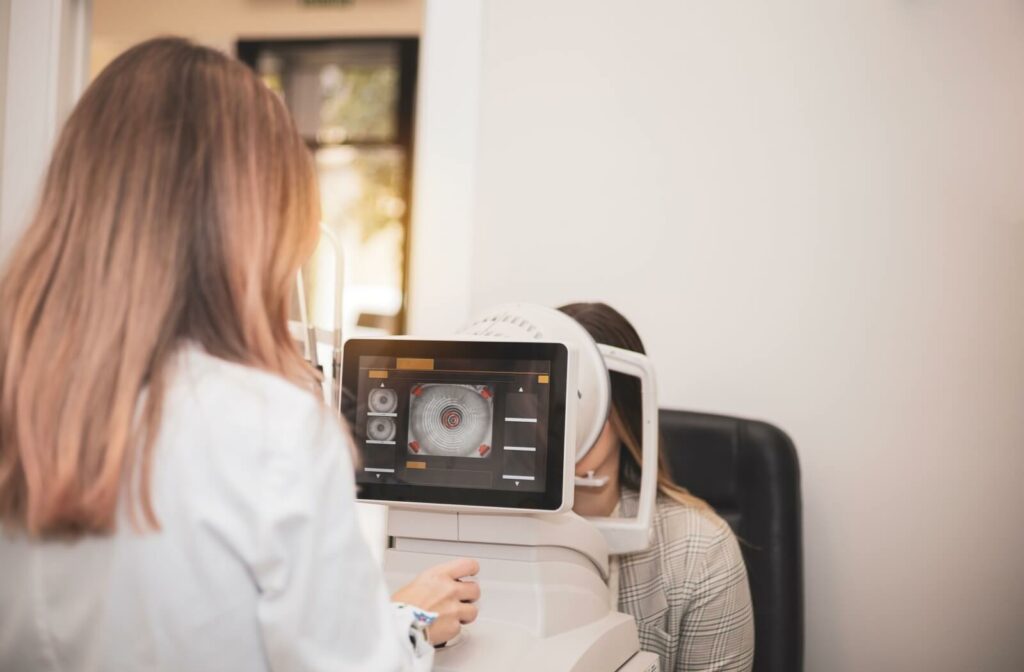When you think about vision problems, nearsightedness and farsightedness likely come to mind. They’re common refractive errors known to affect your everyday vision. However, there are plenty of other conditions that also impact your vision. Astigmatism is an eye condition characterized by a misshapen cornea or lens, causing blurry and distorted vision.
Astigmatism usually stays relatively stable. You may experience some minor prescription changes over the years, but this is often simply due to age-related changes in the eye. If you ever notice significant changes in your prescription, visit your optometrist as soon as you can to discuss treatment.
What is Astigmatism?
At the front of your eye, you have a thin, clear, and dome-shaped tissue called the cornea. Along with the lens of the eye, the cornea responsible for bending light to project images to your retina. The cornea’s spherical shape helps bend and focus light.
However, sometimes the cornea or lens doesn’t develop properly. Instead of curving in a uniform manner, the cornea or lens is more oval or cylindrical with mismatched curves. This condition is called astigmatism.
The Types of Astigmatism
There are 2 types of astigmatism:
- Corneal astigmatism, where the defect or irregularity is on the cornea
- Lenticular astigmatism, where the defect or irregularity is on the lens
From there, astigmatism is broken down into 2 other categories:
- Regular astigmatism, where the eye is shaped improperly but maintains a uniform curve
- Irregular astigmatism, where the eye isn’t completely round and has an uneven overall curve
Astigmatism can also occur with other refractive errors. However, regardless of the specific type in question, the symptoms of astigmatism often remain the same.
The Symptoms of Astigmatism
Astigmatism often causes:
- Blurry or distorted vision
- Eye strain or discomfort
- Headaches
- Difficulty seeing at night
- Frequent squinting
These symptoms can be quite frustrating, affecting your everyday life. It becomes more difficult to drive, read, write, or even watch television with reduced visual capacity.
Does Astigmatism Worsen Over Time?
It’s important to note that sudden, significant changes in your vision are rare, and they should always be met with concern. While astigmatism may worsen over the years, it’s unusual to notice a severe and sudden change in your prescription.
Age-related changes, trauma or injury, or keratoconus can cause astigmatism to worsen over time.
Age-Related Changes
Over the years, your eyes will undergo many changes. Sometimes, these are minor. You may experience a small change in your prescription as your vision naturally worsens over time. For the most part, this is harmless. The lens itself often just becomes a little less flexible and has a harder time focusing. When you have astigmatism, this can lead to worsening vision.
Eye Trauma
The human eye is an extremely sensitive organ, susceptible even to indirect damage. After recent trauma to the head, like due to a fall or blow, vision changes are a common problem.
If you ever experience trauma around or on your eyes, you should visit your optometrist as soon as you can. They can examine the area to determine if you’re at risk of vision loss due to your injury.
Keratoconus
Keratoconus is a condition where the cornea gradually becomes thinner and more conical in shape. When this develops alongside astigmatism, symptoms often worsen. This requires specialized treatment from an experienced optometrist to effectively manage your symptoms.
When to Visit the Optometrist
Your vision is precious to your everyday life. It’s crucial to pay attention to any changes and address them as soon as you can.

Regular eye exams can detect problems early and help manage eye conditions. They let your optometrist thoroughly examine your eyes to determine if there are any significant changes. They can then recommend appropriate treatments to help you preserve your vision.
Any unusual symptoms should be noted and mentioned to your optometrist. Early detection and treatment can make a big difference in preventing complications and maintaining clear, comfortable vision. You should visit your optometrist if you experience:
- Noticeable worsening of vision
- Frequent headaches
- Persistent eye strain
- Difficulty performing daily tasks due to poor vision
How is Astigmatism Treated?
If you’re diagnosed with astigmatism, your optometrist will begin creating a plan to restore your vision. Typically, this is done through specialty contact or eyeglass lenses.
These lenses are designed to counteract the irregular shape of your cornea. They adjust the light so it can enter the eye at a new angle, accommodating your refractive error to give you clearer vision. Toric contact lenses are specialty contact lenses designed to correct astigmatism.
For adults with a more stable prescription, laser eye surgery is also an option. This can be an effective way to permanently correct your astigmatism. The procedure reshapes your cornea using precision laser technology, allowing you to maintain clear vision without relying on corrective lenses. However, not everybody qualifies for laser surgery. You’ll need to schedule a consultation with your optometrist beforehand to determine if you’re eligible.
Get Help with Your Vision
Don’t overlook a sudden change in your vision. While some changes in the eye are natural, others may warrant concern–especially sudden, significant changes. If you’re experiencing anything unusual, come talk to our team at Vivid Eye Care. We’re here to help, so book an appointment with us today!






















